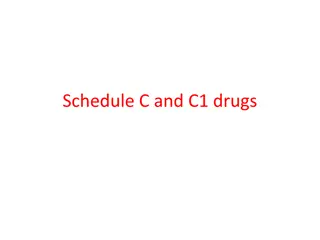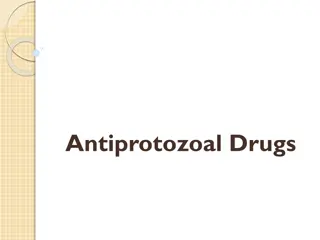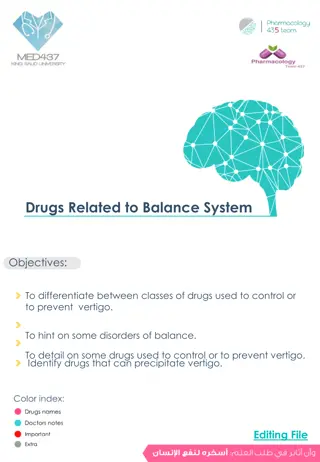Understanding Schedule H and Schedule H1 Drugs
Schedule H and Schedule H1 drugs are categories of prescription medications with specific regulations regarding their supply, labeling, and sale. While antibiotics, anti-TB drugs, and habit-forming substances have been categorized under Schedule H1, both schedules require maintaining records of sales, purchases, prescriptions, patient and doctor details. The implementation of Schedule H1 was deemed necessary due to the rising cases of antibiotic resistance and the need for stricter regulations in the dispensing of certain medications.
Download Presentation

Please find below an Image/Link to download the presentation.
The content on the website is provided AS IS for your information and personal use only. It may not be sold, licensed, or shared on other websites without obtaining consent from the author. Download presentation by click this link. If you encounter any issues during the download, it is possible that the publisher has removed the file from their server.
E N D
Presentation Transcript
Conditions of Sch. H1 drug: The Supply of a drug specified in Schedule H1 shall be recorded in a separate register at the time of the supply giving the name and address of the prescriber, the name of the patient, the name of the drug and the quantity supplied and such record shall be maintained for three years and be open for inspection.
If it contains a drug substance specified in Schedule H1, the drug formulation shall be labelled with the symbol Rx which shall be in Red and conspicuously displayed on the left top corner of the label and shall also be labelled with the following word in a box with red background as mentioned below in warning section.
SCHEDULE H1 DRUG WARNING: It is Dangerous to take this preparation except in accordance with the Medical Advice Not to be Sold by retail without the prescription of a Registered Medical Practitioner.
Difference between Schedule H and Schedule H1: There is not any major difference between schedule H and schedule H1 drugs but antibiotics, anti-TB drugs and habit forming that were fall under schedule H category was moved to a new sub category that is known as Schedule H1. Schedule H and H1, both categories shall be sold under prescription of a Registered Medical Practitioner only but norm regarding drug fall under Schedule H1 are strict.
A proper record of every sale, purchase, prescription copy, patient detail, doctor details under which prescription drugs are sold out etc. shall be maintained for at least three years for schedule H1 drugs where there is no requirement for maintaining record for drug which fall under schedule H drugs.
Why there is need of Schedule H1? In recent time, number of cases of antibiotic resistance diseases are increasing. One of the main cause of antibiotic resistance is easy availability and self medication. There was urgent requirement of implementation of any strict laws that Schedule H was not available to implement.
In Indian medicine market whether it will be possible to implement Schedule H1 policy: Where infrastructure at ground level is of third class. Even in some area there is a lot of Medical Store running without a License or registered pharmacist. One another major problem in Indian Pharmaceutical supply system is that there is a much more chance of drugs without any invoice from its sources i.e. manufactures. In some states where there is tendency and demand of drugs without proper billing. The main reason of this practice is difficulty of getting a particular drug license for retail shop and different tax role at different states.
Our drug department also plays a major role in promoting this practices. Corruption is key of this bad practice of pharmaceutical sector. RMP in India have a strong hold particularly in rural area and in areas where there is no medical facilities. For cheap and easy medicine they are beneficial but our country does not have sufficient amount of doctors to feed the requirement of increasing population. So these so called RMP s is now necessity of some areas in India. These are the person even does not know the definition of antibiotics and recommend stronger to stronger antibiotic for minor illnesses.
Adulterated and inferior quality medicines come in market due to not having proper drug distribution system. Secondly we haven t any system which can distinguish between generic and branded products. On other hand our Drug control system having such drawbacks that anyone can easily escape from it. Political power and Mafia interference also effect the system. In recent years Indian Drug department making a policies to make it at international level but we think there is lot of improvement is required at zero level to make policies effective. Without these we can t establish a USA type drug delivery system in India. Medicine should be considered life saving not just like a Karyana Store where any one can demand and get. Until we improve government system , we can not make a healthier and safer India.
Schedule J: Diseases which a drug may not purport to prevent or cure.- No drug may purport or claim to prevent or cure or may convey to the intending user thereof any idea that it may prevent or cure, one or more of the diseases or ailments specified in Schedule J. No drug may purport or claim to procure or assist to procure, or may convey to the intending user thereof any idea that it may procure or assist to procure, miscarriage in women. Explanation. Diseases and ailments (by whatever name described) which a drug may not purport to prevent or cure or make claims to prevent or cure.
AIDS Angina Pectoris Appendicitis Arteriosclerosis Baldness Blindness Bronchial Asthma Cancer and Benign tumour Cataract Change in colour of the hair and growth of new hair. Change of foetal sex by drugs. Congenital malformations Deafness Diabetes Diseases and disorders of uterus. Epilepticfits and psychiatric disorders Encephalitis Fairness of the skin Form, structure of breast Gangrene
Genetic disorders Glaucoma Goitre Hernia High/low Blood Pressure Hydrocele Insanity Increase in brain capacity and improvement of memory. Improvement in height of children/adults. Improvement in size and shape of the sexual organ and in duration of sexual performance Improvement in the strength of the natural teeth. Improvement in vision Jaundice/Hepatitis/Liver disorders Leukaemia Leucoderma Maintenance or improvement of the capacity of the human being for sexual pleasure.
Mental retardation, subnormalities and growth Myocardial infarction Obesity Paralysis Parkinsonism Piles and Fistulae Power to rejuvinate Premature ageing Premature greying of hair Rheumatic Heart Diseases Sexual Impotence, Premature ejaculation and spermatorrhoea Spondylitis Stammering Stones in gall-bladder, kidney, bladder Vericose Vein.























